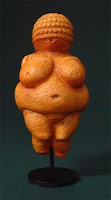The 'Sacred' Feminine?
 feminine was captivated in her representation. She had no voice, no soul, just a body from which all life sprung. This body was round, curved, voluptuous, and the center of worship by both men and women. But it was within this context of sexual power that woman came to be defined, her ability to give birth and nurture creation made her the ultimate icon of worship. But she was also a force to be feared. By the Neolithic era, man learned that the only way to survive and sustain his progeny, was by controlling the natural resources around him. Hydraulic engineering became necessary for civilizations to develop and produce--irrigation for floods, boats for transport, dams for storing water--were just some of the many ways men learned to control resources. But it was also in this need to control nature that men learned that the only way to become like the gods they so admired and sustain their future, would be to control women's sexual appetites. After all, women had a sexuality that could make men fall to their knees, lose their pride--unable to break away from the 'destructive' spell.
feminine was captivated in her representation. She had no voice, no soul, just a body from which all life sprung. This body was round, curved, voluptuous, and the center of worship by both men and women. But it was within this context of sexual power that woman came to be defined, her ability to give birth and nurture creation made her the ultimate icon of worship. But she was also a force to be feared. By the Neolithic era, man learned that the only way to survive and sustain his progeny, was by controlling the natural resources around him. Hydraulic engineering became necessary for civilizations to develop and produce--irrigation for floods, boats for transport, dams for storing water--were just some of the many ways men learned to control resources. But it was also in this need to control nature that men learned that the only way to become like the gods they so admired and sustain their future, would be to control women's sexual appetites. After all, women had a sexuality that could make men fall to their knees, lose their pride--unable to break away from the 'destructive' spell.Stories in ancient folklore are testaments to this and serve as a reminder that female power produced a threat to male survival. Ancient Sumerian text tells the story of Inanna, queen of heaven and earth, the most revered goddess of ancient times. "Inanna, known to Semites as Ishtar, was also referred to as the first daughter of the moon and the mor ning and evening star...she was a multifaceted goddess with prolific powers, including the power over fertility and the fecundity of plants, animals, and humans" (Agha-Jaffar, 18). It is not shocking, however, that the story concludes with Inanna's descent into the netherworld when she takes her lover, the earthly farmer Dumuzi, as her husband and releases him from her capture. She then vows full loyalty to her new husband, surrendering her powers so that her husband, and all future earthly rulers from the Sumerian line, may rule as all-powerful kings. The same kings we read about on cuneiform scrolls.
ning and evening star...she was a multifaceted goddess with prolific powers, including the power over fertility and the fecundity of plants, animals, and humans" (Agha-Jaffar, 18). It is not shocking, however, that the story concludes with Inanna's descent into the netherworld when she takes her lover, the earthly farmer Dumuzi, as her husband and releases him from her capture. She then vows full loyalty to her new husband, surrendering her powers so that her husband, and all future earthly rulers from the Sumerian line, may rule as all-powerful kings. The same kings we read about on cuneiform scrolls.
 power to the men in their life. Another instance is the Hindu goddess Kali, or the 'Destroyer' that devours everything in her path. She is one of the wives of Shiva, and is portrayed as fierce, monstrous, and insatiable. "Her black color, suggestive of the darkness is at the beginning and at the end of life, reminds us of the inevitable confrontation with our own mortality...Kali adorns her otherwise naked body with skulls and limbs around her neck and waist" (Agha-Jaffar, 163). These skulls and limbs which are proudly exhibited are of the men in her life. As Kali is represented as the 'destroyer' of life--her autonomy makes her dangerous and must be controlled. This is what the Hindus refer to as 'shakti' or feminine sexual energy. Shakti can destroy or create life--the message in the story of Kali is clear--leave the woman independent, she may destroy life--control and channel her energy to the men in her life, she may create life.
power to the men in their life. Another instance is the Hindu goddess Kali, or the 'Destroyer' that devours everything in her path. She is one of the wives of Shiva, and is portrayed as fierce, monstrous, and insatiable. "Her black color, suggestive of the darkness is at the beginning and at the end of life, reminds us of the inevitable confrontation with our own mortality...Kali adorns her otherwise naked body with skulls and limbs around her neck and waist" (Agha-Jaffar, 163). These skulls and limbs which are proudly exhibited are of the men in her life. As Kali is represented as the 'destroyer' of life--her autonomy makes her dangerous and must be controlled. This is what the Hindus refer to as 'shakti' or feminine sexual energy. Shakti can destroy or create life--the message in the story of Kali is clear--leave the woman independent, she may destroy life--control and channel her energy to the men in her life, she may create life. Agha-Jaffar, Tamara, ed. Women and Goddesses: In Myth and Sacred Text. Pearson Education, 2005.
'Venus of Willendorf' statuette, limestone, found in Willendorf, Austria in 1908, dated 24-22,000 B.C.



Comments